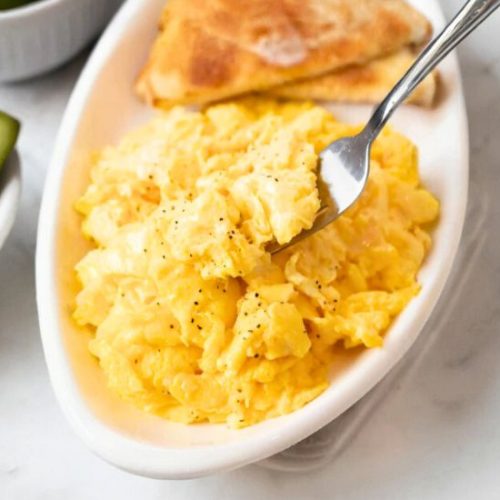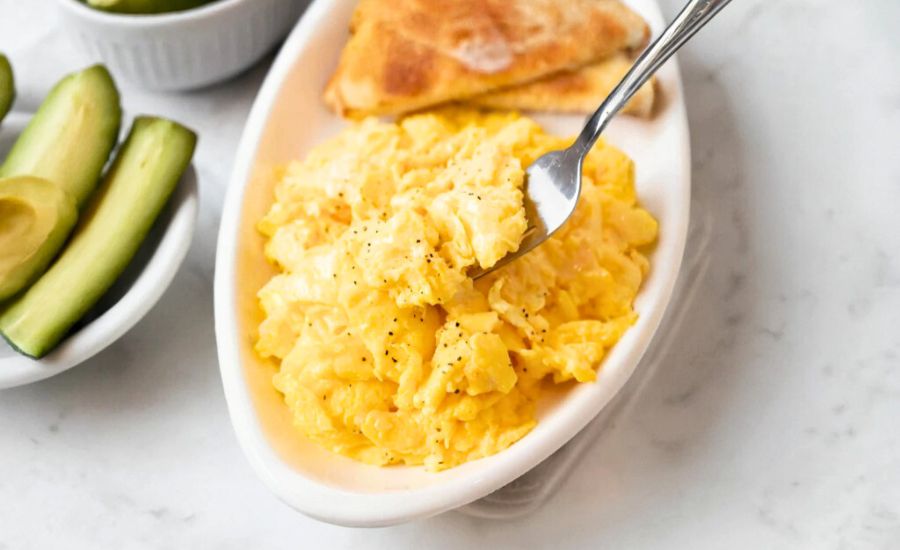All products are selected by our editorial team for quality. If you buy through our links, we may earn a small commission at no extra cost to you.
This Fluffy Scrambled Eggs recipe stands out for its luxurious texture, rich flavor, and quick preparation—making it a breakfast classic that’s elevated without being complicated.
What makes it particularly special is its use of simple yet strategic techniques: low heat, vigorous whisking, and a touch of cheese for both taste and structure.
Unlike most scrambled egg recipes that rely on milk or cream, this version skips those additives and instead achieves creaminess through careful handling and butter alone.
The result? Ultra-fluffy, tender eggs that are far from ordinary.
From a nutritional standpoint, this recipe offers a great balance of high-quality protein and healthy fats while keeping carbs to an absolute minimum—just 1 gram per serving.
Eggs provide complete protein and are rich in vitamins like B12 and D, as well as choline, which supports brain function.
The addition of cheddar cheese boosts the calcium and protein content while also enhancing satiety.
It’s an ideal low-carb, high-protein option for anyone looking to start their day with sustained energy and minimal sugar crash.
Best of all, this dish is incredibly fast—ready in just 10 minutes—making it perfect for busy mornings, solo meals, or even a last-minute dinner.
It’s also adaptable: you can serve it as-is, in a wrap, or as part of a hearty breakfast platter.
Whether you’re eating clean, doing keto, or just craving something satisfying and wholesome, this scrambled eggs recipe checks all the boxes.
Must-Have Tools for Perfect Results
Cuisinart 7-Inch Nonstick Skillet
Perfect for cooking two eggs, this skillet ensures even heat distribution and easy flipping. The nonstick surface prevents sticking, making cleanup a breeze.
A reliable nonstick skillet like this is a must-have for eggs, pancakes, and quick sauté jobs.
Silicone Spatula
Essential for gently folding the eggs without deflating them, preserving their fluffiness. It’s also heat-resistant and versatile for everything from batters to stir-fries.
Wire Whisk
Vigorously whisking the eggs is key to incorporating air and achieving the light, fluffy texture.
A good whisk is a kitchen essential for sauces, dressings, and baking.
White Serving Platter
Presentation matters! A clean, modern platter makes your meal feel café-worthy and is great for serving anything from breakfast to appetizers.

Fluffy Scrambled Eggs
Equipment
- 1 7-inch nonstick skillet
- 1 small mixing bowl
- 1 wire whisk
- 1 silicone spatula
- 1 serving plate
Ingredients
- 2 large eggs
- 2 tablespoons salted butter
- ¼ cup shredded cheddar cheese
- Chopped fresh chives for garnish (optional)
- Salt and black pepper to taste
Instructions
- Whisk the Eggs Thoroughly: Crack the eggs into a small mixing bowl. Use a wire whisk to beat them vigorously for a full minute until the mixture is pale and slightly frothy. This step is key to incorporating air for a fluffy finish.
- Melt Butter Slowly: Place a 7-inch nonstick skillet over low heat. Add the butter and let it melt gradually until it starts to foam slightly—this ensures a gentle, even cooking surface.
- Add the Eggs Off-Heat: Remove the pan briefly from the heat. Pour the beaten eggs into the pan. Give the top of the mixture another light whisk, keeping the whisk near the surface without scraping the pan bottom.
- Return to Heat and Whisk: Set the skillet back over low heat. Continue whisking softly as the eggs begin to foam at the top. Once foam is visible, sprinkle in the shredded cheddar and lightly whisk again to incorporate the cheese.
- Begin Gentle Folds: Allow the eggs to sit undisturbed for about 5–7 seconds. Then, using a silicone spatula, gently push the set edges of the eggs toward the center, tilting the pan so raw egg flows into the cleared space.
- Rotate and Fold: Repeat this motion—pushing set egg inward and tilting—until most of the eggs have formed soft, fluffy curds and only a little moisture remains.
- Finish with Residual Heat: Remove the skillet from the heat. Let the remaining warmth finish cooking the eggs. Lightly fold the eggs a few more times so that any wet spots are evenly set.
- Serve and Season: Gently divide the eggs into smaller portions with the spatula to resemble traditional scrambles. Season with salt and freshly ground pepper, garnish with chives (if using), and serve right away.
Notes
- For extra richness, you can stir in ½ tablespoon of sour cream, heavy cream, or cream cheese along with the eggs.
- These scrambled eggs are fantastic served inside breakfast tacos, alongside toast, or wrapped in a warm tortilla.
- Avoid medium or high heat—low and slow is the secret to tender, fluffy eggs.
- Want to double the recipe? Use an 8-inch skillet to accommodate 4 eggs without crowding the pan.
Chef’s Secrets for Perfect Eggs
The key to achieving irresistibly fluffy scrambled eggs lies in gentle handling and low heat.
Whisking the eggs thoroughly before cooking incorporates air, creating lightness and a cloud-like texture.
Using a low-temperature cooking method prevents the eggs from becoming rubbery or dry, allowing them to cook slowly and evenly.
Removing the pan briefly from the heat before adding the eggs helps maintain this gentle cooking environment.
Incorporating real butter instead of oil adds richness and helps develop that melt-in-your-mouth softness.
Adding shredded cheddar cheese partway through cooking not only enhances flavor but also introduces a creamy texture that balances perfectly with the eggs’ fluffiness.
Finally, letting residual heat finish cooking the eggs off the stove ensures they stay tender without overcooking.
Serving Suggestions to Elevate Meals
Fluffy scrambled eggs are incredibly versatile and pair beautifully with a range of sides and dishes.
For a hearty breakfast, serve them with toasted sourdough or whole-grain bread for added crunch.
They also make a fantastic filling for breakfast tacos or wraps—try adding avocado slices, salsa, or hot sauce for a flavorful kick.
Pairing with fresh fruit or a light salad can brighten the meal and provide refreshing contrast.
For a more indulgent brunch, accompany the eggs with sautéed mushrooms or roasted cherry tomatoes, which bring savory depth and color to the plate.
Garnishing with fresh chopped chives or herbs adds a pop of freshness and visual appeal.
Storage Tips for Best Freshness
Scrambled eggs are best enjoyed fresh right after cooking to appreciate their fluffy texture and delicate flavor.
However, if you have leftovers, store them in an airtight container in the refrigerator within two hours of cooking.
Properly stored, they will keep well for up to 1–2 days. When reheating, do so gently on low heat or in short bursts in the microwave to avoid drying them out.
Adding a small pat of butter or a splash of milk during reheating can help restore moisture and softness.
Avoid freezing scrambled eggs, as the texture tends to become rubbery and watery upon thawing.
Frequently Asked Questions About Eggs
1. Can I use egg substitutes or just egg whites for this recipe?
You can substitute with egg whites or egg replacers, but the texture will be less rich and fluffy because the yolks contribute fat and flavor essential to this recipe’s creamy softness. Adding a little butter or cream can help compensate.
2. Why shouldn’t I use medium or high heat for scrambled eggs?
Higher heat causes eggs to cook too quickly, resulting in a rubbery texture and loss of moisture.
Low and slow cooking allows the eggs to set gently, preserving tenderness and creating fluffy curds.
3. Can I make this recipe dairy-free?
Yes! You can replace butter with dairy-free margarine or oils like olive or avocado oil, though the flavor and texture will differ slightly.
Skip the cheese or use a plant-based cheese alternative to keep it dairy-free.
4. How do I avoid overcooking scrambled eggs?
Remove the pan from heat when the eggs are still slightly moist and creamy.
Residual heat will finish cooking them without drying out the eggs. Folding gently also helps maintain their softness.
5. Is it necessary to whisk the eggs for a full minute?
While you can whisk less, taking the time to vigorously whisk for about a minute incorporates more air, which is essential for that light, fluffy texture. This step really transforms ordinary scrambled eggs into something special.
This recipe is inspired by Thecozycook and has been carefully refined to enhance clarity, streamline preparation steps, and ensure accurate results. We’ve also included health benefits, nutritional highlights, and Must-Have Tools to help you get the best results every time you cook.


